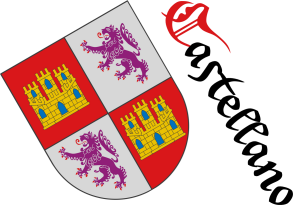
Balaguer, municipality of
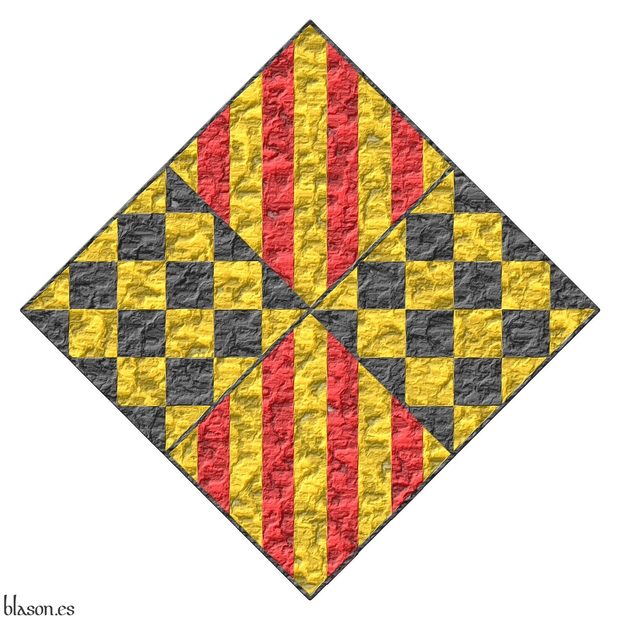
Quarterly per saltire: 1 and 4 Or, four pallets Gules; 2 and 3 chequey Or and Sable.
Escudo cuartelado en sotuer: 1o y 4o de oro, cuatro palos de gules; 2o y 3o ajedrezado de oro y sable.
Arms interpreted with: a lozenge-shaped shield; all tinctures in flat Or, Gules, and Sable; and a heavily beaten metal finish.
Balaguer is the capital of the comarca of La Noguera in the province of Lleida. It was the capital of the county of Urgell under Ponce I of Urgell.
The quartering per saltire, which could also be called quartered in cross, is defined in English as «per saltire», [The Heraldry Society; 2013; page 8].
Blazon keywords: Quarterly per saltire, Pale, Chequey, Or, Gules and Sable.
Style keywords: Tiled, Plain tincture and Hard metal.
Classification: Interpreted, Civic, Coat of arms and Kingdom of Aragon.
Bearer: Balaguer, municipality of.


Teresa of Entenza

Countess of Urgell, Viscountess of Ager, Lady of Alcolea de Cinca, died in 1327.
Dimidiated: 1 Or, four pallets Gules; 2 chequey Or and Sable.
Escudo dimidiado: 1o de oro, cuatro palos de gules; 2o ajedrezado de oro y sable.
Arms interpreted with: a round-bottom shield; all tinctures in flat Or, Gules, and Sable; and a heavily beaten metal finish.
A dimidiated coat of arms is the result of combining two shields of arms by taking the dexter half of the first and the sinister half of the second.
Dimidiation was used in the 13th and 14th centuries to combine, for instance, the arms of two families.
Its blazoning method does not consist of describing what appears in each of the resulting quarters, but rather, by stating from the beginning that it is dimidiated, describing the original coats of arms. Thus, in this particular case of the arms of Teresa of Entenza, it is not stated that there are only two pallets in the first quarter, but that it is dimidiated and has four pallets, so the reader must know that from the four pallets, only the first two are visible due to the dimidiation.
This method of dimidiating the arms of predecessors results in very beautiful and original designs, but depending on the charges and figures involved, in other cases the result may be unrecognisable or even absurd.
Blazon keywords: Dimidiated, Pale, Chequey, Or, Gules and Sable.
Style keywords: Semi-circular, Plain tincture and Hard metal.
Classification: Interpreted, Personal, Coat of arms and Kingdom of Aragon.
Bearer: Teresa of Entenza.


Peter II of Urgell
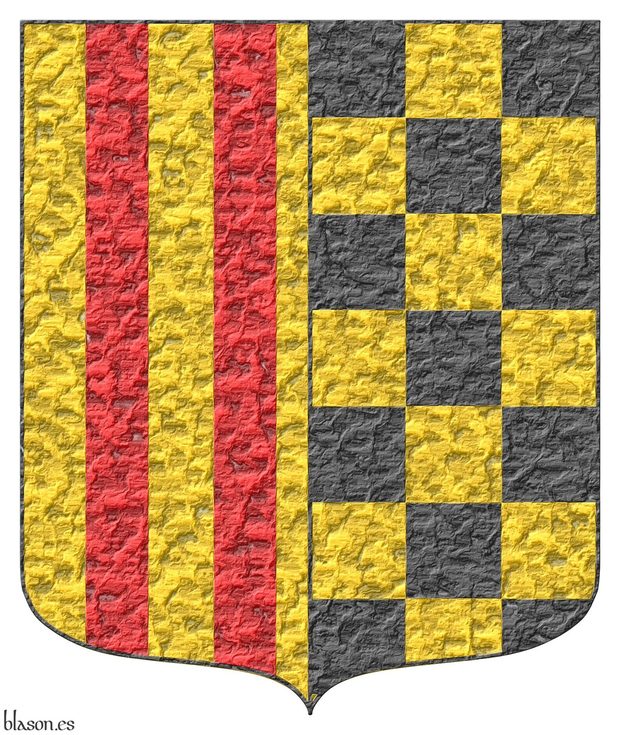
Count of Urgell, Viscount of Àger, Baron of Entença, Antillón, and Alcolea de Cinca (1340–1408).
Dimidiated: 1 Or, four pallets Gules; 2 chequey Or and Sable.
Escudo dimidiado: 1o de oro, cuatro palos de gules; 2o ajedrezado de oro y sable.
Arms interpreted with: the escutcheon in a pointed and rounded shape; the tinctures of the pales and the chequey rendered in flat inks Or, Gules, and Sable; and the whole finished with a highly hammered metal effect.
Peter II of Urgell (1340–1408), Count of Urgell, Viscount of Àger, and Baron of Entença, Antillón, and Alcolea de Cinca, was a prominent figure of 14th-century Catalan nobility and grandson of Alfonso IV of Aragon.
Blazon keywords: Dimidiated, Pale, Chequey, Or, Gules and Sable.
Style keywords: Ogee, Plain tincture and Hard metal.
Classification: Interpreted, Personal, Coat of arms and Kingdom of Aragon.
Bearer: Peter II of Urgell.


James II of Urgell
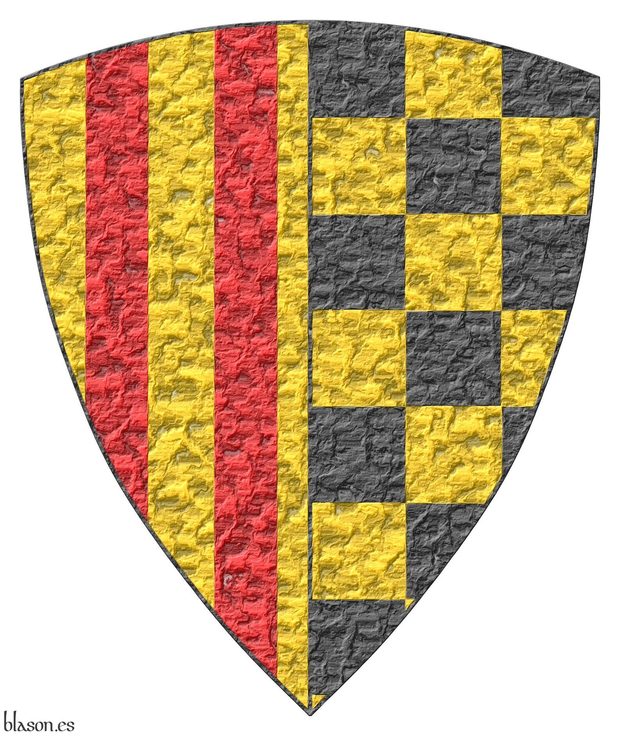
Known as the Unfortunate, Count of Urgell, Viscount of Àger, Baron of Fraga, Antillón and Alcolea de Cinca (1380–1433).
Dimidiated: 1 Or, four pallets Gules; 2 chequey Or and Sable.
Escudo dimidiado: 1o de oro, cuatro palos de gules; 2o ajedrezado de oro y sable.
Arms interpreted with: a shield shape of convex-sided triangles; the tinctures of the pallets and the chequey are flat gold, gules and sable; and the whole design has a heavily hammered metal finish.
James II of Urgell, 1380–1433, known as the Unfortunate, Count of Urgell, Viscount of Àger, and Baron of Fraga, Antillón and Alcolea de Cinca, was one of the main claimants to the throne after the death of Martin I of Aragon. His rejection of the Compromise of Caspe led to his defeat and imprisonment.
Blazon keywords: Dimidiated, Pale, Chequey, Or, Gules and Sable.
Style keywords: Triangular curved, Plain tincture and Hard metal.
Classification: Interpreted, Personal, Coat of arms and Kingdom of Aragon.
Bearer: James II of Urgell.


![Ver [Pedro IV de Aragón; 1353] en referencias bibliográficas. Libro abierto, hojas de plata, filo de oro, guardas de gules, tapas de sable.](../css/Libro.Bibliografia.png)
Pedro IV de Aragón; 1353
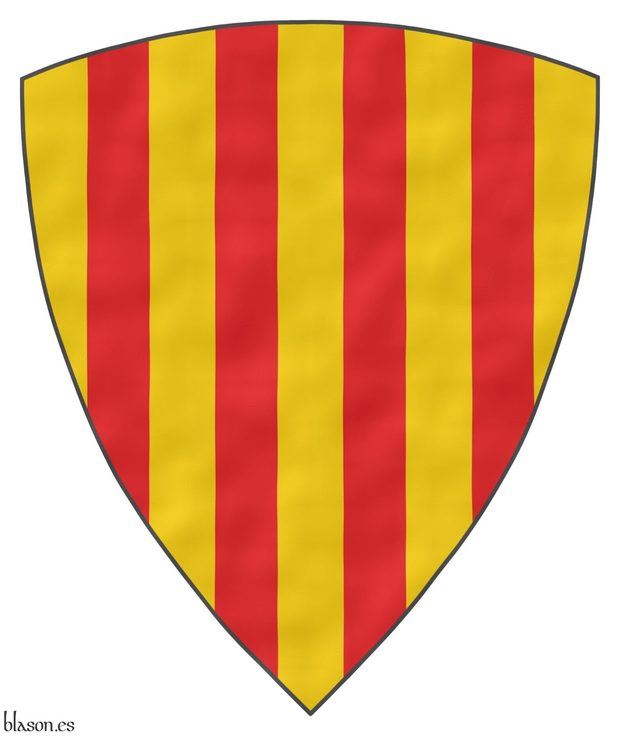
Pedro IV of Aragon, also known as Pedro III of Aragon as he himself called, «Ordinance made by the very high and excellent Prince and Lord Lord Don Pedro the third King of Aragon, on the manner in which the Kings of Aragon will be consecrated and they themselves will be crowned», in the Royal Aragonese Chancery, 1353.
Bibliographical reference of century XIV.
The author is Pedro IV de Aragón.
The following article cites this bibliographic reference:
External link:


![Ver [Portolés, J.; Molino, M. del; 1590] en referencias bibliográficas. Libro abierto, hojas de plata, filo de oro, guardas de gules, tapas de sable.](../css/Libro.Bibliografia.png)
Portolés, J.; Molino, M. del; 1590

Jerónimo Portolés and Miguel del Molino, Ad Illustrisimos D. D. pradicti Regni Dipputatos, «Scholiorum Sive Adnotationum ad Repertorium Michaelis Molini Super Foris et Observantiis Regni Arago», Tertia pars, Cum Licentia Superiorum, Casaraugustae, per Laurentium de Robles, Regni Aragonum, et Universitatis Typographum, Zaragoza, 1590.
Foral law, history and charters of the Kingdom of Aragon.
Bibliographical reference of century XVI.
The 2 authors are Portolés, Jerónimo and Molino, Miguel del.
Bibliographical reference mentioned in the following article:
External resource:


Cáceres, Province of
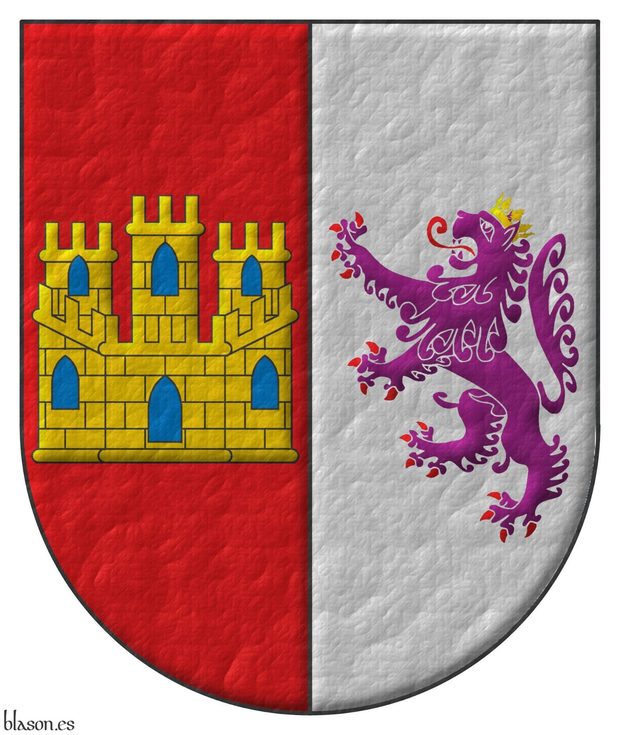
Party per pale: 1 Gules, a castle triple towered Or, port and windows Azure, masoned Sable; 2 Argent, a lion rampant Purpure, armed and langued Gules, crowned Or.
Escudo partido: 1o de gules, un castillo de oro, aclarado de azur, mazonado de sable; 2o de plata, un león rampante de púrpura, armado y lampasado de gules, coronado de oro.
Civic coat of arms interpreted by me as follows: the shield has a semicircular (round) base; the field, the castle and the lion are illuminated; the lion and its crown are outlined in the colour of the field; the open royal crown and the castle are outlined in Sable, in the case of the castle because it is masoned; and the whole has a canvas texture.
Blazon keywords: Party per pale, Argent, Purpure, Gules, Or, Azure, Castle, Lion, Port and windows, Masoned, Rampant, Armed, Langued, Crowned, Crown and Open royal crown.
Style keywords: Semi-circular, Illuminated and Fabric.
Classification: Interpreted, Civic, Coat of arms and Kingdom of Castile and Leon.
Bearer: Cáceres, Province of.


Province of Cáceres with Cross of Alcántara
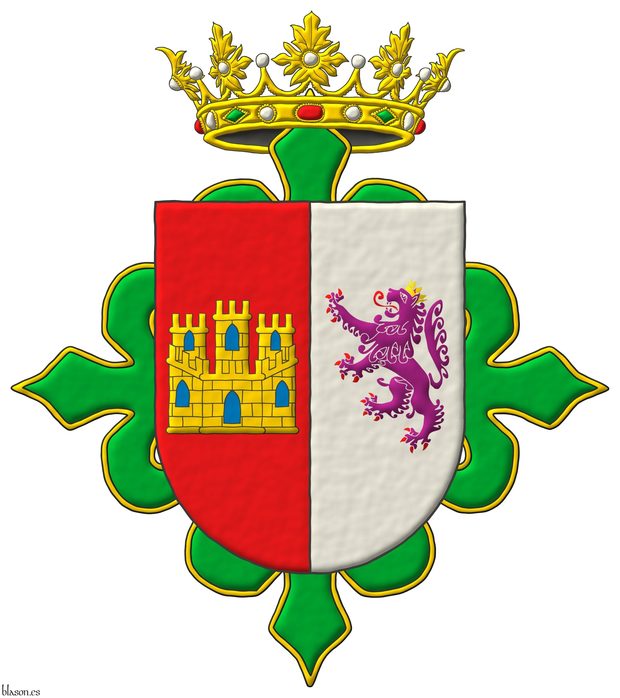
Party per pale: 1 Gules, a castle triple towered Or, port and windows Azure, masoned Sable; 2 Argent, a lion rampant Purpure, armed and langued Gules, crowned Or. Crest: An open royal crown. Behind the shield a cross of Alcantara.
Escudo partido: 1o de gules, un castillo de oro, aclarado de azur, mazonado de sable; 2o de plata, un león rampante de púrpura, armado y lampasado de gules, coronado de oro. Timbrado de una corona real abierta. Acolada detrás del escudo una cruz de Alcántara.
Civic coat of arms interpreted by me as follows: the shield of arms has a semicircular (round) base; the quarters are enameled and illuminated in the tinctures Argent and Gules; the castle, the lion, the Cross of Alcántara and the crown are illuminated; the lion and its crown are outlined in the colour of the field; the open royal crown, the Cross of Alcántara and the castle are outlined in Sable; the Cross of Alcántara is fimbriated Or; and the whole has a watercolor finish.
In [Medél, R.; 1846; plate 35, illustration 5] one can see his interpretation of the Cross of Alcántara.
Blazon keywords: Argent, Purpure, Gules, Or, Azure, Party per pale, Castle, Lion, Port and windows, Masoned, Rampant, Armed, Langued, Crowned, Crest and mantling, Crown, Open royal crown, Behind the shield, Cross, Cross of Alcantara and Cross couped.
Style keywords: Semi-circular, Illuminated and Watercolor.
Classification: Interpreted, Civic and Coat of arms.
Bearer: Cáceres, Province of.

Continue with: Province of Cáceres, structured blazons in parallel.
-
Language
-
Categories of heraldry
-
Divisions of the field
- Without divisions
- Party per pale
- Party per fess
- Party per bend
- Party per bend sinister
- Tierce
- Tierce sinister
- Tierced per pale
- Tierced per fess
- Tierced per bend
- Tierced pallwise inverted
- Quarterly
- Quarterly per saltire
- Gyronny
- Party per fess, the chief per pale
- Party per pale, the sinister per fess
- Party per fess, the base per pale
- Party per pale, the dexter per fess
- Chapé
- Chaussé
- Embrassé
- Contre-embrassé
- Party per chevron
- Enté
- Enté en point
- Flanched
-
Metals
-
Colours
-
Furs
-
Other tinctures
-
Ordinaries and sub-ordinaries
-
Diminutives of the ordinaries
-
Geometric charges
-
Composite ordinaries
-
Inanimate charges from Nature
Atom, Crescent, Diamond, Emerald, Estoile, Increscent, Lightning flash, Moon, Mount, Mullet, Mullet of four points, Orbital, Plough of Ursa Major, Rainbow, Ray of the sun, River, Sea, Snowflake, Sun, Sun in splendour, Sun of May, Trimount, Water and Wave.
-
Vegetal charges from Nature
Acorn, Apple, Apple tree, Ash, Bluebonnet, Camellia, Chrysanthemum, Cinquefoil, Cornflower, Dogwood flower, Double rose, Elm, Fleur de lis, Flower, Gourd, Holm oak, Hop cone, Kapok tree, Laurel, Lily, Linden, Lotus flower, Madonna lily, Mexican cedar tree, Oak, Olive tree, Palm tree, Plantain plant, Pomegranate, Poplar leaf, Rose, Shamrock, Sunflower, Thistle, Tree, Tulip, Vine and Wheat.
-
Animal charges from Nature
Badger, Bald eagle, Barbel, Barn owl, Bear, Beaver, Beetle, Bighorn sheep, Blackbird, Boar, Brach hound, Bull, Doe, Dog, Dolphin, Dove, Eagle, Elephant, Falcon, Female figure, Fish, Flame, Fly, Fox, Frog, Goat, Goldfinch, Goose, Heron, Horse, Hummingbird, Jaguar, Lark, Leopard, Lion, Lion passant, Lion rampant guardant, Lioness, Lynx, Male figure, Martlet, Merino ram, Owl, Panther, Parrot, Peacock, Pelican, Pelican in her piety, Puffin, Quetzal, Raven, Roe deer, Rooster, Savage, Seagull, Serpent, She-wolf, Stag, Starling, Talbot, Tyger, Vulture, Warren hound and Wolf.
-
Parts of natural charges
Arm, Beak, Branch, Caboshed, Chest, Claw, Covert, Dorsal fin, Eagle claw, Ermine spot, Escallop, Feather, Foot (palmiped), Foreleg, Forepaw, Hand, Head, Heart, Hoof, Leaf, Neck, Ostrich feather, Palm frond, Paw, Roe deers' attires, Shoulder, Sprig, Stags' attires, Stem, Swallow-tail, Tail, Tail addorsed, Tail fin, Talon, Tooth, Trunk, Trunk (elephant), Two hands clasped, Two wings in vol, Udder, Wheat spike, Wing and Wrist.
-
Artificial charges
Ace of spades, Anchor, Anvil, Arch, Arm vambraced, Armillary sphere, Arrow, Axe, Bell, Bell tower, Beret, Bonfire, Book, Bookmark, Bow, Branding iron, Bridge, Broken, Buckle, Cannon, Cannon dismounted, Cannon port, Canopy roof, Carbuncle, Castle, Celtic Trinity knot, Chain, Chess rooks, Church, Clarion, Clay pot, Closed book, Club, Column, Comb, Compass rose, Conductor's baton, Cord, Covered cup, Crozier, Crucible, Cuffed, Cup, Cyclamor, Dagger, Double vajra, Drum, Ecclesiastical cap, Fanon, Federschwert, Fleam, Four crescents joined millsailwise, Galician granary, Garb, Gauntlet, Geometric solid, Grenade, Halberd, Hammer, Harp, Host, Hourglass, Key, Key ward, Knight, Knot, Lantern, Letter, Line, Loincloth, Menorah, Millrind, Millstone, Millwheel, Monstrance, Mortar, Mullet of six points pierced, Nail, Non-classic artifact, Norman ship, Number, Oar, Oil lamp, Open book, Page, Pair of scales, Parchment, Pestle, Piano, Pilgrim's staff, Plough share, Polish winged hussar, Port, Portcullis, Potent, Quill, Ribbon, Rosette of acanthus leaves, Sabre, Sackbut, Sail, Scroll, Scythe, Sheaf of tobacco, Ship, Skirt, Spear, Spear's head, Stairway, Star of David, Step, Sword, Symbol, Tetrahedron, Torch, Tower, Trident, Trumpet, Turret, Two-handed sword, Wagon-wheel, Water-bouget, Wheel, Winnowing fan and With a turret.
-
Immaterial charges
Angel, Archangel, Basilisk, Dragon, Dragon's head, Garuda, Golden fleece, Griffin, Heart enflamed, Justice, Mermaid, Our Lady of Mercy, Ouroboros, Paschal lamb, Pegasus, Phoenix, Sacred Heart of Jesus, Saint George, Sea-griffin, Trinity, Triton, Unicorn, Winged hand and Wyvern.
-
External elements
-
Heraldic creations
-
References
-
Formats
-
Keywords on this page
Port and windows, Behind the shield, Watercolor, Chequey, Armed, Azure, Balaguer, municipality of, Bibliography, Structured and parallel blazons, Castle, Ogee, Crown, Open royal crown, Crowned, Cross, Cross of Alcantara, Cross couped, Quarterly per saltire, Four, Cáceres, Province of, Dimidiated, Fabric, Coat of arms, Personal, Gules, Illuminated, Interpreted, James II of Urgell, Langued, Lion, Tiled, Masoned, Semi-circular, Hard metal, Or, Pale, Party per pale, Peter II of Urgell, Argent, Without divisions, Civic, Purpure, Rampant, Kingdom of Aragon, Kingdom of Castile and Leon, Sable, Century XIV, Crest and mantling and Plain tincture.
